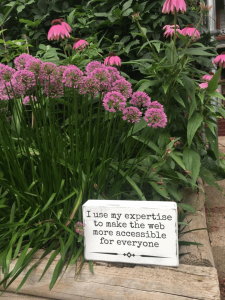 Digital marketing in the twenty-teens has a daunting number of components businesses have to develop strategies for dealing with. You have to have a social media strategy, a mobile strategy, and a standout website optimized for search. Behind the scenes, you have to make decisions about content management systems, establish a process for sifting through analytics, and set up workflows for nurturing leads. As easy as it is to be overwhelmed by all the gadgets and all the emerging channels for reaching customers, there is one element of your digital marketing strategy that has to be nailed down before any of the others can even have a chance of working for you. Mastering all the platforms and channels won’t do you any good if you don’t have a process in place for creating quality content.
Digital marketing in the twenty-teens has a daunting number of components businesses have to develop strategies for dealing with. You have to have a social media strategy, a mobile strategy, and a standout website optimized for search. Behind the scenes, you have to make decisions about content management systems, establish a process for sifting through analytics, and set up workflows for nurturing leads. As easy as it is to be overwhelmed by all the gadgets and all the emerging channels for reaching customers, there is one element of your digital marketing strategy that has to be nailed down before any of the others can even have a chance of working for you. Mastering all the platforms and channels won’t do you any good if you don’t have a process in place for creating quality content.
What Is Quality Content Exactly?
Quality content is media material that has value to your potential customers and is easy for them to find. That second part is where things like keywords in the titles, URLs, and headings come in, along with share options for various social platforms and targeted emails. But if your blog post, podcast, video, white paper, or e-book has no value to consumers they’re not going to search for it or share it anyway. So what does it mean for content to have value? And how do you go about creating content that’s valuable to your potential customers?
Know Who Your Potential Customers Are and Answer Their Questions
Most businesses hate the idea of leaving anyone at all out of their sales efforts. But one of the biggest mistakes you can make with your content is trying to be all things to all people. So at some point you have to ask yourself who you’re targeting with your materials. Once you know who your content is for, then you can move on to asking what challenges, concerns, desires, or problems might make them interested in your business’s products or services. From this point, you can begin to imagine the kinds of titles and links your potential customers will be the most likely to click on.
The practical steps to take to learn about your customers may involve sitting down with your salespeople to talk about what challenges and questions past customers have brought to them. You can also learn a lot from analytics. At some point, you may even what to hold focus groups or conduct online surveys. A simple shortcut, however, is to go to forums that discuss topics associated with your industry and see what kinds of questions people are asking. If someone’s asking questions about a product, it’s likely they’re thinking about buying it. And if they’re posting the question on a forum like Quora, they’re likely searching for it on Google too, and even keeping an eye out for links in their social media feeds.
Where do you get the answers and how do you create the actual content? There’s no getting around the need to have a couple of people who can write on staff. You may even want photographers, graphic designers, or videographers, depending on your specific marketing goals. And you’ll have to establish some process for your content people to either research information on their own or get insights from the area experts in your company through interviews or presentations.
Tailor Content to the Various Stages of Customers’ Decision-Making Process
Some of your content will simply help customers educate themselves about your industry. Some of it will help them understand how the products and services your business provides can help address their specific challenges. You want to get your name out there, and you want to establish some trust with the people who may later make a purchase from you. But learning about your industry or products is just the first stage in the decision-making process. So you’ll want to have some quality content that helps them with the subsequent steps as well, things like comparing products from competing brands, overcoming objections, and evaluating competing vendors.
Consumers today do their best to avoid commercials and advertising. If they want to find out about a product, they jump online and do a search or ask their friends. What this means is that your customers have already gone through a large portion of the decision-making process by the time they contact you or visit your store. So the best strategy for any business is to make sure they’re the ones who are providing customers with the initial information they seek out online. You increase your chances of being the business customers eventually reach out to if it’s your blog they’ve been reading to learn about your products and services. You offer them quality content, and in exchange they remember your name when it comes time to buy.
Business Articles | Business 2 Community
(295)
Report Post








